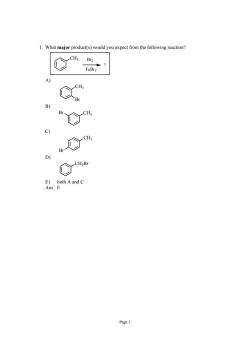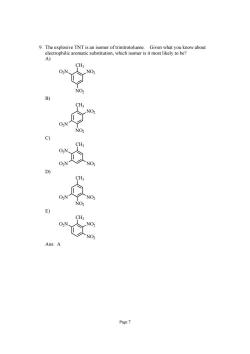北京化工大学:《有机化学》课程教学资源(章节测验,含答案)Chapter 16 Electrophilic Attack on Derivatives of Benzene:Substituents Control Regioselectivity

1.What major product(s)would you expect from the following reaction? Br D) ng both A and C Page 1
Page 1 1. What major product(s) would you expect from the following reaction? CH3 ? Br2 FeBr3 A) CH3 Br B) Br CH3 C) CH3 Br D) CH2Br E) both A and C Ans: E

2.What major product(s)would you expect from the following reaction? % C) D No. ns uh A and C Page2
Page 2 2. What major product(s) would you expect from the following reaction? NO2 ? HNO3 H2SO4 A) NO2 NO2 B) O2N NO2 C) NO2 O2N D) NO2 SO3H E) both A and C Ans: B

3.What major product would you expect from the following reaction? OH e Page3
Page 3 3. What major product would you expect from the following reaction? OH ? HNO3 H2SO4 A) OH NO2 B) OH O2N C) OH NO2 D) OH NO2 E) OH NO2 Ans: A

What major product(s)would you expect from the following reaction? net-a AlCla CH 、CH HC-Co D)both A and C E)no reaction occurs Ans:E Page 4
Page 4 4. What major product(s) would you expect from the following reaction? H3C C O Cl NO2 ? AlCl3 A) NO2 C O CH3 B) NO2 O CH3 C C) NO2 H3C O C D) both A and C E) no reaction occurs Ans: E

H.C NO 1.HNO3.H2SOa 2.Br2.FeBr3 3.CHCOCL,AICIs C) 1.CHgCOCL,AICI3 2.HN0,H2S04 3.Br2,FeBr D)both A and B E)both Band C Ans:C 6.Rank the following aromatics in order of decreasing reactivity toward electrophilic aromatic substitution (most reactive least reactive). A B C D A>C>D>B D-C>A-D Page5
Page 5 5. Which of the following sequences of reactants would you expect to convert benzene to the substituted aromatic shown below? H C NO2 3C O Br ? A) 1. HNO3, H2SO4 2. Br2, FeBr3 3. CH3COCl, AlCl3 B) 1. Br2, FeBr3 2. CH3COCl, AlCl3 3. HNO3, H2SO4 C) 1. CH3COCl, AlCl3 2. HNO3, H2SO4 3. Br2, FeBr3 D) both A and B E) both B and C Ans: C 6. Rank the following aromatics in order of decreasing reactivity toward electrophilic aromatic substitution (most reactive > least reactive). CH3 NO2 Br OH A B C D A) A > C > D > B D) D > A > C > B B) D > C > A > B E) C > A > D > B C) B > C > A > D Ans: D

7.What would be the proper name of the molecule below? henzotoluene 3-methylnapthalene 3-methyldibenzene Ans:D 8.What product(s)would you expect from the following reaction? HS04 c29 c) Q C,⑦ E)both Band D Ans:E Page6
Page 6 7. What would be the proper name of the molecule below? CH3 A) benzotoluene D) 2-methylnapthalene B) 3-methylnapthalene E) 1-methylnapthalene C) 3-methyldibenzene Ans: D 8. What product(s) would you expect from the following reaction? O O HNO3 H2SO4 ? A) O O O2N B) O O NO2 C) O O NO2 D) O O NO2 E) both B and D Ans: E

9.The explosive TNT is an isomer oftrinitrotoluene. CH; NO Page7
Page 7 9. The explosive TNT is an isomer of trinitrotoluene. Given what you know about electrophilic aromatic substitution, which isomer is it most likely to be? A) CH3 O2N NO2 NO2 B) CH3 NO2 O2N NO2 C) CH3 O2N O2N NO2 D) CH3 O2N NO2 NO2 E) CH3 O2N NO2 NO2 Ans: A

10.What reagent(s)would be required to accomplish the following reaction? CH CHCHCH: CH. CH: CH;CH2C(=O)CI,AICI CH;CH2CH2CI,AICls Reagents in A,followed by HaNNH2.KOH,A followed by zinc and HCI 1laetahsenccoaeeamwhcmcantmnmndipot-atna A)Nitration D)Friedel-Crafts alkylation B)Friedel-Crafts acylation Bromination E)Chlorination Page8
Page 8 10. What reagent(s) would be required to accomplish the following reaction? CH3 CH3 CH3 CH3 CH2CH2CH3 ? A) CH3CH2C(=O)Cl, AlCl3 B) CH3CH2CH2Cl, AlCl3 C) Reagents in A, followed by H2NNH2, KOH, Δ D) Reagents in B followed by zinc and HCl E) CH3CH=CH2, H2SO4 Ans: C 11. In which electrophilic aromatic substitution reaction can unintended poly-substitution (i.e., disubstitution, trisubstitution, etc.) be a problem? A) Nitration D) Friedel-Crafts alkylation B) Friedel-Crafts acylation E) Chlorination C) Bromination Ans: D

represent the mos Page9
Page 9 12. One of the interesting aspects of azulenes is that they are soluble in strong aqueous acids because of a reaction with H+ . Which of the structures below would represent the most stable form of protonated azulene? ? H+ azulene A) H H B) H H C) H H D) H H E) H H Ans: D

13.Which of the following statements is not true of the process shown below +E→ H Benzene is less reactive with E*than other alkenes are. The overall process is a substitution reaction. There are three resonance structures of the intermediate possible. hese statements are true 0N、 NO, both A and C Ans:Bone o would be formed Page 10
Page 10 13. Which of the following statements is not true of the process shown below? E E H - H+ + E+ A) Benzene is less reactive with E+ than other alkenes are. B) The overall process is a substitution reaction. C) There are three resonance structures of the intermediate possible. D) The first step is rate determining. E) All these statements are true. Ans: E 14. Carefully consider the effect of the nitro groups on the stability of the intermediates involved as you decide which product(s) the reaction shown provides. O2N NO2 NO2 ? Br2 FeBr3 A) O2N NO2 NO2 Br B) O2N NO2 NO2 Br C) O2N NO2 NO2 Br D) both A and C E) none of these would be formed Ans: B
按次数下载不扣除下载券;
注册用户24小时内重复下载只扣除一次;
顺序:VIP每日次数-->可用次数-->下载券;
- 北京化工大学:《有机化学》课程教学资源(章节测验,含答案)Chapter 15 Benzene and Aromaticity:Electrophilic Aromatic Substitution.pdf
- 北京化工大学:《有机化学》课程教学资源(章节测验,含答案)Chapter 14 Delocalized Pi Systems:Investigation by Ultraviolet and Visible Spectroscopy.pdf
- 北京化工大学:《有机化学》课程教学资源(章节测验,含答案)Chapter 13 Alkynes:The Carbon–Carbon Triple Bond.pdf
- 北京化工大学:《有机化学》课程教学资源(章节测验,含答案)Chapter 12 Reactions of Alkenes.pdf
- 北京化工大学:《有机化学》课程教学资源(章节测验,含答案)Chapter 11 Alkenes; Infrared Spectroscopy and Mass Spectrometry.pdf
- 北京化工大学:《有机化学》课程教学资源(章节测验,含答案)Chapter 10 Using Nuclear Magnetic Resonance Spectroscopy to Deduce Structure.pdf
- 北京化工大学:《有机化学》课程教学资源(章节测验,含答案)Chapter 09 Further Reactions of Alcohols and the Chemistry of Ethers.pdf
- 北京化工大学:《有机化学》课程教学资源(章节测验,含答案)Chapter 08 Hydroxy Functional Group:Alcohols:Properties, Preparation, and Strategy of Synthesis.pdf
- 北京化工大学:《有机化学》课程教学资源(章节测验,含答案)Chapter 07 Further Reactions of Haloalkanes:Unimolecular Substitution and Pathways of Elimination.pdf
- 北京化工大学:《有机化学》课程教学资源(章节测验,含答案)Chapter 06 Properties and Reactions of Haloalkanes - Bimolecular Nucleophilic Substitution.pdf
- 北京化工大学:《有机化学》课程教学资源(章节测验,含答案)Chapter 05 Stereoisomers.pdf
- 北京化工大学:《有机化学》课程教学资源(章节测验,含答案)Chapter 04 Cycloalkanes.pdf
- 北京化工大学:《有机化学》课程教学资源(章节测验,含答案)Chapter 03 Reactions of Alkanes:Bond-Dissociation Energies, Radical Halogenation, and Relative Reactivity.pdf
- 北京化工大学:《有机化学》课程教学资源(章节测验,含答案)Chapter 02 Structure and Reactivity:Acids and Bases, Polar and Nonpolar Molecules.pdf
- 北京化工大学:《有机化学》课程教学资源(章节测验,含答案)Chapter 01 Structure and Bonding in Organic Molecules.pdf
- 北京化工大学:《有机化学》课程教学资源(模拟试卷)有机B期末试题.pdf
- 北京化工大学:《有机化学》课程教学资源(模拟试卷)有机B期末试卷及其答案.pdf
- 北京化工大学:《有机化学》课程教学资源(模拟试卷)有机A期末试卷及其答案.pdf
- 北京化工大学:《有机化学》课程教学资源(模拟试卷)有机B期中试卷及其答案.pdf
- 北京化工大学:《有机化学》课程教学资源(模拟试卷)有机B期中试卷.pdf
- 北京化工大学:《有机化学》课程教学资源(章节测验,含答案)Chapter 17 Aldehydes and Ketones:The Carbonyl Group.pdf
- 北京化工大学:《有机化学》课程教学资源(章节测验,含答案)Chapter 18 Enols, Enolates, and the Aldol Condensation:a, b-Unsaturated Aldehydes and Ketones.pdf
- 北京化工大学:《有机化学》课程教学资源(章节测验,含答案)Chapter 19 Carboxylic Acids.pdf
- 北京化工大学:《有机化学》课程教学资源(章节测验,含答案)Chapter 20 Carboxylic Acid Derivatives.pdf
- 北京化工大学:《有机化学》课程教学资源(章节测验,含答案)Chapter 21 Amines and Their Derivatives:Functional Groups Containing Nitrogen.pdf
- 北京化工大学:《有机化学》课程教学资源(章节测验,含答案)Chapter 22 Chemistry of Benzene Substituents:Alkylbenzenes, Phenols, and Benzenamines.pdf
- 北京化工大学:《有机化学》课程教学资源(章节测验,含答案)Chapter 23 Ester Enolates and the Claisen Condensation:Synthesis of b-Dicarbonyl Compounds; Acyl Anion Equivalents.pdf
- 北京化工大学:《有机化学》课程教学资源(章节测验,含答案)Chapter 24 Carbohydrates:Polyfunctional Compounds in Nature.pdf
- 北京化工大学:《有机化学》课程教学资源(章节测验,含答案)Chapter 25 Heterocycles:Heteroatoms in Cyclic Organic Compounds.pdf
- 北京化工大学:《有机化学》课程教学资源(章节测验,含答案)Chapter 26 Amino Acids, Peptides, Proteins, and Nucleic Acids:Nitrogen-Containing Polymers in Nature.pdf
- 北京化工大学:《有机化学》课程教学资源(习题与答案)Chapter 01 Structure and Bonding in Organic Molecules.pdf
- 北京化工大学:《有机化学》课程教学资源(习题与答案)Chapter 02 Structure and Reactivity:Acids and Bases, Polar and Nonpolar Molecules.pdf
- 北京化工大学:《有机化学》课程教学资源(习题与答案)Chapter 03 Reactions of Alkanes:Bond-Dissociation Energies, Radical Halogenation, and Relative Reactivity.pdf
- 北京化工大学:《有机化学》课程教学资源(习题与答案)Chapter 04 Cycloalkanes.pdf
- 北京化工大学:《有机化学》课程教学资源(习题与答案)Chapter 05 Stereoisomers.pdf
- 北京化工大学:《有机化学》课程教学资源(习题与答案)Chapter 06 Properties and Reactions of Haloalkanes - Bimolecular Nucleophilic Substitution.pdf
- 北京化工大学:《有机化学》课程教学资源(习题与答案)Chapter 07 Further Reactions of Haloalkanes:Unimolecular Substitution and Pathways of Elimination.pdf
- 北京化工大学:《有机化学》课程教学资源(习题与答案)Chapter 08 Hydroxy Functional Group:Alcohols:Properties, Preparation, and Strategy of Synthesis.pdf
- 北京化工大学:《有机化学》课程教学资源(习题与答案)Chapter 09 Further Reactions of Alcohols and the Chemistry of Ethers.pdf
- 北京化工大学:《有机化学》课程教学资源(习题与答案)Chapter 10 Using Nuclear Magnetic Resonance Spectroscopy to Deduce Structure.pdf
